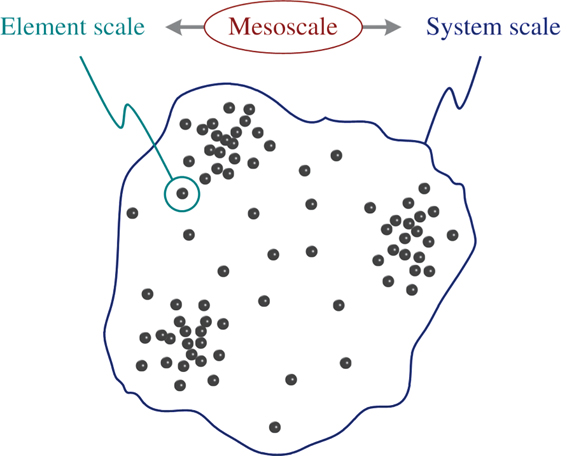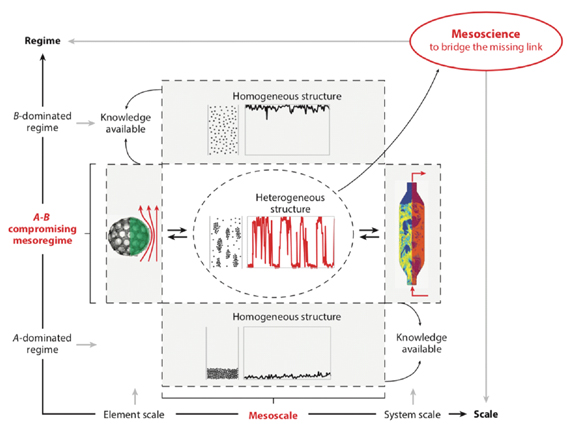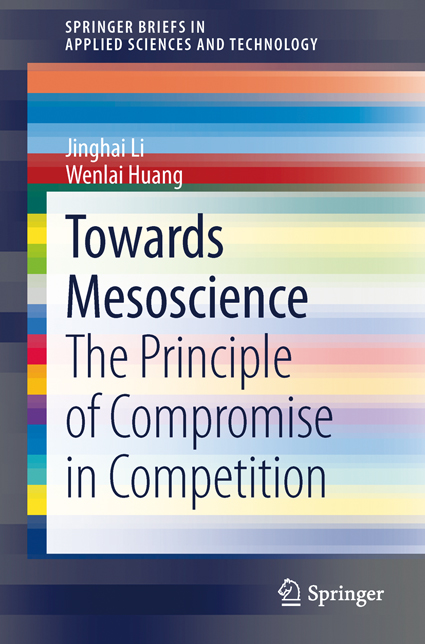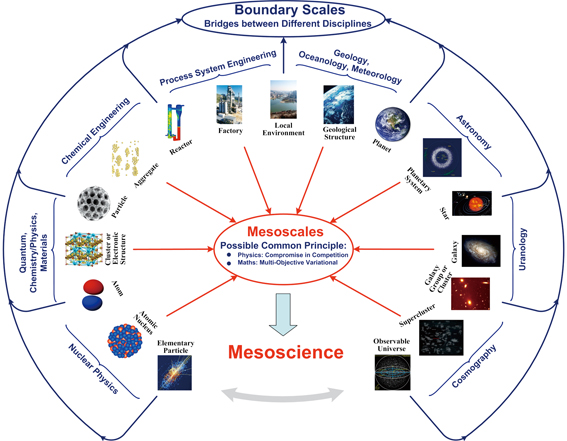By SONG Jianlan (Staff Reporter)
To understand the physical world in which we live every day, scientists have spared no effort to delve into the details of elementary particles known to human beings, aiming to establish an overall picture based on the properties and behaviors of such building blocks; on the other hand, they have also went to all lengths to understand and predict the global development of complex systems like galaxies and climate dynamics, by averaging the details of local structures in certain domains, in the hope of reducing the uncopiable massive datasets produced if following the elementary approach.
With no doubt, both approaches have proved their validity to some extent.
Still, however, explorations in either direction might have its own drawbacks, an interdisciplinary panel of renowned scientists warned, and suggested that an emerging approach they termed as “mesoscience” might open a new horizon.

Mesoscience looks at a world between the microscale and the macroscale. (Image: By Li J., et al.)
Over 30 distinguished scientists from Australia, Britain, China, France, Hungary, Italy, Switzerland, and USA, convened in Beijing from May 27 to 29 to prepare for the launching of a new international academic organization called “International Panel of Mesoscience.” They urged more attention be given to this new research approach, which focuses on a world once lost between the micro- and the macroscopic lenses of ours.
Co-chaired by Profs. Richard Williams (UK), Robin Batterham (AUS) and Richard Zare (USA), the Panel discussed the potential challenges and future development of mesoscience. In an announcement entitled “A Call for Work in Mesoscience,” they encouraged more studies in this field to verify further the generality and applicability of this emerging approach.
Mesoscience places emphasis on mesoscale – a scale between the microscale and the macroscale – to identify spatiotemporal complex structures of complex systems that are widely investigated by scientists. At the mesoscale, impacts from both the elementary and system scales converge; nevertheless, traditional approaches neglected its importance and resulted in distorted understanding of the global system, panelists agreed.
The panel, consisting of scientists from different disciplines ranging from chemistry, physics, mathematics, psychology, to chemical engineering, anticipated that this new perspective might improve our understanding of the world.
Reconciling Micro- and Macroscopic Views
It is accepted as an accurate, mostly idealistic method to understand the global dynamics of a complex system by tracking in detail the behavior of every comprising unit. For example, to understand a chemical reaction by formulating the dynamics of every comprising atom following the ab initio principle. However, this consumes a great deal of computing resources, said Prof. LI Jinghai, Member of the Chinese Academy of Sciences (CAS).
Accuracy is costly when describing a complex system, he said. “Taking into account every unit of the system produces such a massive dataset that it could be unaffordable and, even impossible in reality – this would pose a challenge uncopiable for even the most powerful supercomputer in the world,” LI introduced. Such cases, as observed by researchers in the field including the panelists, he explained, are ubiquitous, like turbulence phenomena, structures of living proteins, cognitive processes, and all collective behaviors or dynamic heterogeneity prevailing in nature, engineering, and society.
This would be uneconomical and impractical at least currently, LI reiterated: “In reality, available computational capacity, which is always limited relative to the demand, sets an upper constraint for the potential accuracy in computation.”
Even worse, sometimes mastery at microscales may not contribute to improving accuracy at a macroscopic scale. A good example might be the fact that entire sequencing of the DNAs of an organism is far from enough for understanding the regulation and operation of its genome.
An alternative strategy often taken by researchers is to bypass this bottleneck by ignoring certain detail of elementary units – by defining average parameters for a certain domain of the system, a model can be fixed to describe the global properties and behaviors of the system, without tracking every detail of the micro-structures.
However, the group of scientists warned that, such averaging approaches generally lead to unsatisfactory accuracy. Particularly, if we directly fix a model to simulate the system without accommodating the critical structures driving the subsystems or the comprising units, the output could be of too low an accuracy and hence fail to predict the global behavior of the system. Complex phenomena usually consist of heterogeneous structures that involve both spatial and temporal complexity, while averaging description could eliminate such spatiotemporal heterogeneity.

Tracking elementary particles can generally give very accurate description of a complex system, but it is highly costly, consuming tremendous computing resources and posing demanding challenges to computational facilities. With aid from Mole-8.5, a powerful supercomputer system whose design adapts to the structural features of the target issue, scientists at the State Key Laboratory of Multiphase Complex Systems, Institute of Process Engineering (IPE), CAS, successfully simulated the dynamic structure of the whole H1N1 influenza virion at the atomic level. (Image: By Xu J., et al.)
However, accurate mastery of elementary units might not automatically lead to good understanding of the global heterogeneous system. Such cases can be frequently found in biochemistry, biology, cognitive process and human behavior research.
This tricky situation could be illustrated by some straightforward cases. For example, as articulated by Prof. Richard Zare, an advocate of mesoscience, when describing the movement of cars on a two-way road, if we simply calculate the average speed of the cars without considering the different directions in which the cars run, the average speed could be close to zero. One can easily tell this is absurd, based on common sense; but what if we need to describe a complex system of which we know very little hence have no “common sense” to lean on?
A possible strategy could be, the mesoscience advocates said, to have the two meet in between.
But how? Using a multiscale approach, a better physical model can be built considering structural parameters, but difficulties might rise in aligning parameters of heterogeneity and closing the formulation of the system.
The key, said the advocates, lies in how to capture and define the feature of critical structures in a “pragmatic” way. Concerning this, they concluded that they have developed a method generally applicable to different systems.
Competition and Compromise
“We found that very often on some interfaces of a complex system, pairs of competing mechanisms prevail. The dynamic development on the interface, which is critical to the whole system, could be seen as a result from the compromise between the two competing mechanisms. Therefore, we can define the structure by formulating the dynamic compromise, and starting from this ‘surrogate unit,’ we can fix an overarching model to predict the situation of the whole system,” introduces LI. “The key is to capture the dominant drivers and identify the compromises inherent,” he continued.
They coined this perspective as mesoscience – it focuses on critical structures between the microscale and the macroscale, where “impacts” from both the elementary and the global scales of the heterogeneous system converge. “Evidence shows that at the mesoscale of a complex phenomenon, such critical structures are subject to not only the interactions at the elementary scale but also the constraints at the systematic scale. Mesoscale structures play important roles in bridging the two boundary scales at a specified domain, governed by the compromise in competition between different dominant mechanisms,” LI explained.

Heterogeneity arises from the compromise between two competing dominant mechanisms in a system. (Image: By Li J., et al.)
From a mesoscience view, complexity of a heterogeneous system originates from the compromise between competing dominant mechanisms. This explains the universal existence of compromises in complex systems. Unfortunately, the advocates argued, traditional approaches ignore this important feature.
Seems we have now identified the critical node in the system – the compromise. However, how should we describe it in a way both feasible and accurate enough for industrial application? Previous efforts of LI and his colleagues might give some clues.

In the case where two competing mechanisms dominate a complex system, changing the constraints at the system scale can result in at least three “regimes.” When either of the two dominant mechanisms prevails, a simple regime manifests “reigned” almost purely by one mechanism. When both mechanisms govern the system in mixed extents, a complex regime manifests at a mesoscale. The three can prevail in succession, depending on the constraining conditions posed by the system. Governed by both mechanisms in competition, the mesoscale regime has “stress” converged from the both extremes of the system. (Image: By Li J., et al.)
From Multiscale to Mesoscience
The State Key Lab of Multiphase Complex Systems at the CAS Institute of Process Engineering (IPE) has been devoted to developing clean, energy-efficient technologies for green industrial production. With aid of computer virtual simulation, this lab aims to address challenges arising from industrial processes involved with multiphase systems, say gas-solid and gas-liquid flows. A major challenge posed by such systems is how to describe the dynamics of the particles: Again, how should we reconcile the dilemma between accuracy and computing capacity?
Drawing on their long-term explorations, this lab developed and proposed a principle called “energy minimization multiscale (EMMS),” and based on this they captured the scenario of balance state on the interfaces constituted by matters of multiple phases. They defined this critical episode with a function featuring the stability condition and put it into repeated verification via experiments and calculations. Further, on this ground they constructed the overarching model of the global system.
In their investigations spanning nearly four decades, this method proved to be valid in various complex systems involving multiphase interfaces, and extended its application to the exploration of different scientific issues, including turbulence and gas-liquid-solid systems. This method further demonstrated its versatility in dealing with issues of emulsion, granular, and nano-flow systems.
Finally, their repeated experiments and simulations of multiphase reactions gave rise to the concept of mesoscience.
The EMMS method did not receive much attention until 1999, when the academia’s ambition to understand the world via fast-developing computer modeling encountered with the concrete ceiling set by computational capacity available for human beings. Just as recalled by Prof. Robin Batterham in his 2016 paper in Engineering, Bruce Edmonds rationalized this restriction in 1999, Citing Bremermann’s theory published in 1967: “It has been calculated that quantum mechanics imposes a limit of bits/gram/sec on the amount of information that can be computed by each gram of matter per second. So even with the mass of the universe and all the time until the heat death of the universe, there is a finite limit to computation.”

A monograph on mesoscience was published by Springer in 2014.
This restriction makes it a virtue to integrate reductionist and holism; the academia began to embrace EMMS as a practical and feasible method, and the industry also found its great value in designing, optimizing, and modulating production processes.
“The theory presented was rigorous; however, I never imagined at the time that such a theory could have a practical impact. After about two decades, I must admit that I was wrong: EMMS has flourished. LI and his team have even been able to apply it in an industrial context and to demonstrate that this theory enjoys a generality that permits it to be applied in a variety of circumstances, thus contributing to disparate technical fields such as software development and virtual process engineering,” commented Prof. Raffaella Ocone, School of Engineering and Physical Sciences, Heriot-Watt University, UK, in her commentary published in the journal Engineering in 2017.
Based on EMMS method LI and his colleagues arrived at the solution and named it mesoscience. Drawing on their theoretical research and case studies over the past decades in this field, LI and his IPE colleague, Prof. HUANG Wenlai composed and published a monograph on this emerging approach in 2014; and the later few years saw more publications in journals clarifying the background, scope, principle, and method of mesoscience.
Closing Gaps in Existing Knowledge System
Given the promising prospects of this approach, explorations in mesoscience won the support from the National Natural Science Foundation of China (NSFC) in the year of 2012, and later in 2016 CAS also offered a hand. More discoveries are in vision; further, this approach is anticipated to play some role in integrating the knowledge and technological systems into a single landscape, and in closing gaps in the existing knowledge system.
Noted of the difficulties in solving some problems in nature, engineering, social science, and humanity based on currently available knowledge, LI proposed breaking traditional thinking patterns and bridging the reductionism and holism perspectives. In his paper titled “Exploring the Logic and Landscape of the Knowledge System: Multilevel Structures, Each Multiscaled with Complexity at the Mesoscale” published 2016 in Engineering, he suggested the possibility of integrating the current knowledge system via mesoscience perspective: “Although all mesoscale problems manifest diversity and complexity, they are likely to meet a common principle governing their common natures, such as heterogeneity, dynamics and phase separation, and so forth.” Nevertheless, due to prevailing thinking patterns either focusing on the element or the system scale, insufficient attention had been given to problems at mesoscales.
Having been proposed to recognize the once neglected scientific principle common for all mesoscale problems, mesoscience might be able to fill this gap, LI advanced. “Gaps in the existing knowledge system should be closed. The mesoscale problems at all levels are common missing links in the knowledge system and, in particular, may follow a common principle. The discovery and confirmation of this principle will induce revolutionary progress in S&T,” he suggested.

As an approach bridging different disciplines, mesoscience is anticipated to play some role in closing gaps in the existing knowledge system. (Image: By Huang W., Li J., and Edwards PP.)
“Unified leaning has always been a common dream among scientists,” in her 2017 commentary in Engineering Prof. Raffaella Ocone expressed her confidence in mesoscience in terms of closing the gaps in current knowledge system. “I called for an adoption of this approach, not only in the way in which we study complexity, but also in the training of the next generation of researchers,” she continued.
LI’s call for change in habitual thinking patterns also caught the eye of Prof. Augusta Maria Paci, Department of Chemical Science and Materials Technology, National Research Council of Italy. “... The paper I read was rather unique; it provides a forward-looking and high-level message that deserves attention from policy-makers and scholars in research and innovation (R&I) activities. … This system-oriented approach can drive decision-makers forward to create a deep change in scientific and technological knowledge generation, production, and delivery at all levels,” she commented in her commentary titled “A Research and Innovation Policy for Sustainable S&T: A Comment on the Essay ‘Exploring the Logic and Landscape of the Knowledge System’” published May 2018 in Engineering.
“It is my belief that the paper by Professor LI can guide our common thinking forward and open up new pathways for understanding global sustainable S&T and for absorbing, filtering, and assessing societal concerns as part of high-level scientific knowledge development. The model proposed by LI provides common principles to consider in S&T to respond to grand challenges with advanced high-level research solutions,” she concluded.
More Exploration Needed
Still, more actions and investigations are needed, the advocates cautioned, to verify the universality and applicability of mesoscience, though more and more evidence supports its validity.
“Of equal importance is the focusing question of whether the mesoscale always involves competition, and if so, whether it is always between two dominant mechanisms. I suspect that more work is required in this area in order to sway the wider scientific community,” observed Robin Batterham, Kernot Professor of engineering, the University of Melbourne, in his commentary published 2016 in Engineering. He deemed that a challenge existing is to find more examples from a wider range of problems in which the mesoscale involves compromise through competition.
LI and his colleagues and cooperators, including Prof. HUANG Wenlai at IPE and Prof. Peter P. Edwards at the Department of Chemistry, University of Oxford, repeatedly remind of the uncertainty in universality and applicability of mesoscience in their publications.
In August 2017, they emphasized that more evidence is needed to verify the universality of its principle, and also its applicability, in a paper they co-authored in the National Science Review, an English-language journal of China that observes disciplinary developments. Meanwhile they called for more studies in this field, particularly case studies in different disciplines.
In November 2017, Prof. LI also expressed his caution in an editorial published in the National Science Review, while anticipating its wider applications and encouraging broader discussions to find out the best way to addressing complex systems. “The proposition of mesoscience was developed primarily from case studies in chemical engineering; its universality needs further investigation and evidence from many vastly different fields. There are still many specific issues to clarify in studying specific systems,” he reiterated.
Now in Beijing, Profs. Ocone, Paci and Batterham all attended the meeting as panelists; and both their optimism and caution were echoed by other panelists. Taking on the floor of their optimism, cautions and concrete ideas, the Panel called for actions to collect opinions and experiences around the scientific world.
Allowing some uncertainty in explorations in the field, the panelists arrived at consensus in terms of raising awareness of this approach, and investing more efforts and resources in this area.
Representatives from the Chinese Association of Science and Technology (CAST), NSFC, and CAS attended the meeting and expressed the willingness of their organizations to continue supporting the development of mesoscience.
The following is the full text of the announcement released at the Preparatory Meeting of the International Panel of Mesoscience:
A Call for Work in Mesoscience
Our World is filled with complex challenges whose solutions matter deeply to society. These challenges are characterised by multiple scales in time and space, involving mechanisms at different levels. A number of modelling approaches have been used in the past. One such approach is based on building blocks, or fundamental constituents, put together to capture system characteristics. Another approach looks at the average properties of a limited sample to infer how the system behaves. Although these approaches have had some successes, there is an alternative; this we call 'Mesoscience'.
Mesoscience proposes that complexity arises from an inevitable compromise between competing factors, such as different mechanisms striving for dominance. Mesoscience bridges bottom-up and top-down approaches through multi-objective optimisation under constraints.
There have been notable successes in a number of chemical processing applications, and the question we are raising is whether this new methodology can be applied more widely. An International Panel has met and considers the approach may well be applicable to several other fields.
This Panel calls for more studies to be made for the application of mesoscience and to look for underlying common themes amenable to the development of a research methodology that we believe, in time, may well become a new branch of science, engineering and technology.

